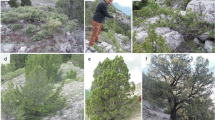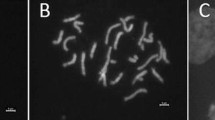Abstract
Cross-incompatibility is the major challenge in inter-sectional distant hybridization between tree peonies (Paeonia sect. Moutan) and herbaceous peonies (Paeonia sect. Paeonia). Most of the intersectional cross combinations rarely produce hybrid progenies or even seeds. However, a combination with Paeonia × lemoinei Rehd. (P. delavayi × P. suffruticosa, tree type) as the pollen parent and P. lactiflora (herbaceous) as the seed parent resulted in many progenies. This research focuses on cytogenetics of two highly compatible intersectional combinations, P. lactiflora ‘Martha W.’ × P. × lemoinei ‘Golden Era’ (‘MW’ × ‘GE’) and P. lactiflora ‘Fen Yun Fei He’ × P. × lemoinei ‘L’Esperance’ (‘FYFH’ × ‘LE’). Karyotype analysis combined with genomic in situ hybridization (GISH) showed that the seed parents, ‘MW’ and ‘FYFH’, are both diploids (2n = 2x = 10, CC), while the pollen parents, ‘GE’ and ‘LE’, are tetraploid (2n = 4x = 20, AABB) and diploid (2n = 2x = 10, AB) respectively. Four progenies from ‘MW’ × ‘GE’, and another four progenies from ‘FYFH’ × ‘LE’, are all triploids (2n = 3x = 15, ABC). P. × lemoinei contributes two sets of chromosomes (AB) showing distinct signals in all tested triploids. The essential of a successful intersectional hybridization is to obtain 2x gametes from tree peony. P. × lemoinei has better compatibility in intersectional hybridization than other tree peony species, probably because of its higher frequency of 2x gamete (unreduced in diploid, or reduced in tetraploid) generation. Tetraploid tree peonies, such as ‘GE’, might produce abundant 2x gametes through normal meiosis, which is the possible reason for their better fertility and superior intersectional compatibility than diploid tree peonies. The mechanism of compatibility in intersectional hybridization is supposed to be a rebalance between the distant divergent parents, tree peonies and herbaceous peonies, triggered by ploidy increase of gametes from tree peonies. The discovery of tetraploid tree peony also provides valuable materials to study the mechanism of polyploidization in sect. Moutan, and to promote the distant hybridization breeding in Paeonia.







Similar content being viewed by others
References
Abbott R, Albach D, Ansell S, Arntzen JW, Baird SJE, Bierne N, Boughman J, Brelsford A, Buerkle CA, Buggs R, Butlin RK, Dieckmann U, Eroukhmanoff F, Grill A, Cahan SH, Hermansen JS, Hewitt G, Hudson AG, Jiggins C, Jones J, Keller B, Marczewski T, Mallet J, Martinez-Rodriguez P, Möst M, Mullen S, Nichols R, Nolte AW, Parisod C, Pfennig K, Rice AM, Ritchie MG, Seifert B, Smadja CM, Stelkens R, Szymura JM, Väinölä R, Wolf JBW, Zinner D (2013) Hybridization and speciation. J Evol Biol 26:229–246
Cheng FY (2007) Advances in the breeding of tree peonies and a cultivar system for the cultivar group. Int J Plant Breed 1:89–104
Gao SM, Yang MH, Zhang F, Fan LJ, Zhou Y (2019) The strong competitive role of 2n pollen in several polyploidy hybridizations in Rosa hybrida. BMC Plant Biol 19:127
Han X (2014) Studies on parental selection of tree peonies and genetic performance of several traits in F1 hybrids. M. D. dissertation, Beijing Forestry University, Beijing. (in Chinese)
He GM, Cheng FY (2006) Morphological observation of sexual reproduction abortion in ‘High Noon’ tree peony. Acta Horticulturae Sinica 33:660–663 (in Chinese)
He GM (2006) Studies on distant cross-breeding and embryo in vitro culture and somatic embryogenesis in tree peonies. Ph. D. Dissertation, Beijing Forestry University. (in Chinese)
Hong DY (2010) Peonies of the world: taxonomy and phytogeography. Kew Publishing, UK
Hong DY (2021) Peonies of the world: phylogeny and evolution. Kew Publishing, UK
Johnston SA, Hanneman RJ (1982) Manipulations of endosperm balance number overcome crossing barriers between diploid solanum species. Science 217:446–448
Kang XY, Zhu ZT (1997) A study on the 2n pollen vitality and germinant characteristics of white populars. Acta Botanica Yunnanica 19:402–406 (in Chinese)
Lafon-Placette C, Kohler C (2016) Endosperm-based postzygotic hybridization barriers: developmental mechanisms and evolutionary drivers. Mol Ecol 25:2620–2629
Li MX, Chen RY (1985) A suggestion on the standardizaton of karyotype analysis in plants. J Wuhan Bot Res 3:297–302 (in Chinese)
Li MX, Zhang XF (1982) Cytogenetic observation of triploid tree peony. Hereditas 4:19–21 (in Chinese)
Page M (2005) The gardener’s peony: herbaceous and tree peonies. Timber Press, Cambridge
Ramsey J, Schemske DW (1998) Pathways, mechanisms, and rates of polyploid formation in flowering plants. Annu Rev Ecol Syst 29:467–501
Saunders AP, Stebbins GL (1938) Cytogenetic studies in Paeonia I. the compatibility of the species and the appearance of the hybrids. Genetics 23:65–82
Storme ND, Mason A (2014) Plant speciation through chromosome instability and ploidy change: cellular mechanisms, molecular factors and evolutionary relevance. Current Plant Biol 1:10–33
Sun JF, Cheng FY (2007) Preliminary report on the introduction of intersectional hybrids between tree and herbaceous peonies. Chin Landsc Archit, 51–54. (in Chinese)
Wang YL (2009) Cross-breeding in tree peony and fertility research of intersectional hybrids. M. D. dissertation, Beijing Forestry University. (in Chinese)
Wister JC (1995) The peonies. The American Peony Society, Hopkins
Xiao JJ (2010) A study on the crossing compatibility and hybrid abortion of Paeonia. M. D. dissertation, Beijing Forestry University, Beijing. (in Chinese)
Yang LH, Zhang JJ, Da Silva JAT, Yu XN (2017) Variation in ploidy and karyological diversity in different herbaceous peony cultivar groups. J Am Soc Hortic Sci 142:272–278
Younis A, Ramzan F, Hwang YJ, Lim KB (2015) FISH and GISH: molecular cytogenetic tools and their applications in ornamental plants. Plant Cell Rep 34:1477–1488
Zhong Y, Cheng FY, He GM, Gao J, Wang R, Du XJ, Wang YL, Liu YY, Cao XJ, Wang Y (2016) Five new peony cultivars bred from inter-sectional hybrids in Paeonia. Scientia Silvae Sinicae 52:164 (in Chinese)
Zhong Y, Du MJ, Liu YX, Cheng FY (2019) Karyotype analysis and meiotic chromosome behavior observation on Paeonia × lemoinei 'High Noon'. J Beijing for Univ 41:68–73 (in Chinese)
Zhong Y, Du MJ, Cheng FY, Li KY, Ji RZ, Cui J (2023) Karyotype and fertility analysis of allotetraploids in tree peony (Paeonia section Moutan). Acta Hortic Sinica 50:1444–1454 (in Chinese)
Zhong Y, Du M, Li K, Cheng F Y (2020) Karyotype analysis of Paeonia × lemoinei ‘High Noon’ based on GISH supplies an improved method for accurate karyotyping of hybrids in Paeonia. Acta Hortic 1283:175–180
Zhou SL, Xu C, Liu J, Yu Y, Wu P, Cheng T, Hong DY (2021) Out of the Pan-Himalaya: evolutionary history of the Paeoniaceae revealed by phylogenomics. J Syst Evol 59:1170–1182
Acknowledgements
This work was supported by the National Natural Science Foundation of China (Grant Number 31971701).
Author information
Authors and Affiliations
Contributions
Conceptualization: Yuan Zhong and Fang-yun Cheng.; methodology: Yuan Zhong, Ming-jie Du, Run-ze Ji and Qi Rong; writing—original draft preparation: Yuan Zhong, Ming-jie Du and Zi-heng. Guan; writing—review and editing: Yuan Zhong and Fang-yun Cheng. All authors have read and agreed to the final version of the manuscript.
Corresponding authors
Ethics declarations
Conflict of interest
The authors declare that they have no known competing financial interests or personal relationships that could have appeared to influence the work reported in this paper.
Additional information
Publisher's Note
Springer Nature remains neutral with regard to jurisdictional claims in published maps and institutional affiliations.
Supplementary Information
Below is the link to the electronic supplementary material.
Rights and permissions
Springer Nature or its licensor (e.g. a society or other partner) holds exclusive rights to this article under a publishing agreement with the author(s) or other rightsholder(s); author self-archiving of the accepted manuscript version of this article is solely governed by the terms of such publishing agreement and applicable law.
About this article
Cite this article
Zhong, Y., Du, Mj., Ji, Rz. et al. Cytogenetic analysis reveals a mechanism of compatibility in distant hybridization between tree peony and herbaceous peony. Euphytica 220, 66 (2024). https://doi.org/10.1007/s10681-024-03326-1
Received:
Accepted:
Published:
DOI: https://doi.org/10.1007/s10681-024-03326-1




